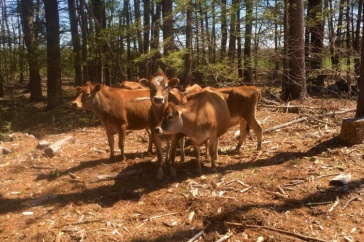
Moocall, a sensor attached to a cow’s tail, can detect when it is likely going into labor and then alert caretakers via text.
It’s the middle of the night, and doctoral student Kayla Aragona has just received a text alert at home on her cell phone from a cow in labor at the UNH Fairchild Dairy Teaching and Research Center.
Moocall — a sensor attached to the cow’s tail — has detected that the cow is highly active, likely due to an increase in contractions.
Aragona has been using Moocall sensors for about four months at Fairchild Dairy, a facility of the New Hampshire Agricultural Experiment Station, to help better monitor pregnant cows during the night. She receives both text alerts and emails from cows about to calve.
Moocall is a sensor attached to the cow’s tail to measure movement patterns triggered by labor contractions. The sensor gathers more than 600 pieces of data per second.
“When properly fastened, Moocall will give me a two-hour notice for a calving by sending me text alerts to my cell phone when a cow is active for one hour and then again when a cow has been active for two hours,” Aragona says. “This makes it easier for me to be here when a calf is born to ensure that the birth goes smoothly.”

Moocall was developed in Ireland after a dairy farmer lost a heifer and a calf during an unattended birth. The sensor was released commercially in 2015, and the company lists UNH as one of the first two university research dairy farms in the U.S. using the technology.
Unattended calving can have significant consequences for dairy farms. According to Virginia Cooperative Extension, almost 50 percent of deaths of calves from birth to 24 hours old are a result of calving difficulty.
Prior to using Moocall, Aragona says she relied on the farm staff to call her, and while UNH has students on site 24 hours a day, no one typically is in the barn from about 10 p.m., following night check, until 4 a.m. When Aragona knew she had a cow close to calving, she would check on her periodically throughout the night — every night — until the cow calved. But this wasn’t conducive to sleeping, especially when considering there are about 70 calves born every year at the Fairchild Dairy.
“With the Moocall sensor, I no longer need to drive in to check on my cows or depend on the farm staff to actually call me, so I can sleep better not worrying about missing a calving. Although I get a few false alarms here and there, I have yet to miss a calving,” she says.
Moocall isn’t foolproof, however. “The funniest experience with Moocall so far has been when I used it on a cow that did not like it. She would rub her tail up against everything and literally bang the sensor against the wall to try to get it to fall off,” Aragona says. “No wonder I got a few false alarms!”
The award-winning Fairchild Dairy Center develops new knowledge and management expertise geared directly toward many state and regional stakeholders. It houses about 80 milking-age Holstein and Jersey cows and approximately 70 growing, replacement animals. Included in that number is the 20-cow, student-managed herd, with the remaining animals devoted primarily to research in the area of dairy nutrition and reproductive biology. Find out more here.
-
Written By:
Lori Tyler Gula, PhD | NH Agricultural Experiment Station | lori.gula@unh.edu | 603-862-1452


















































